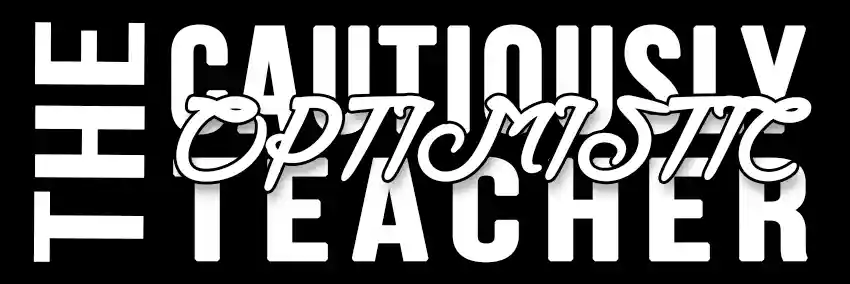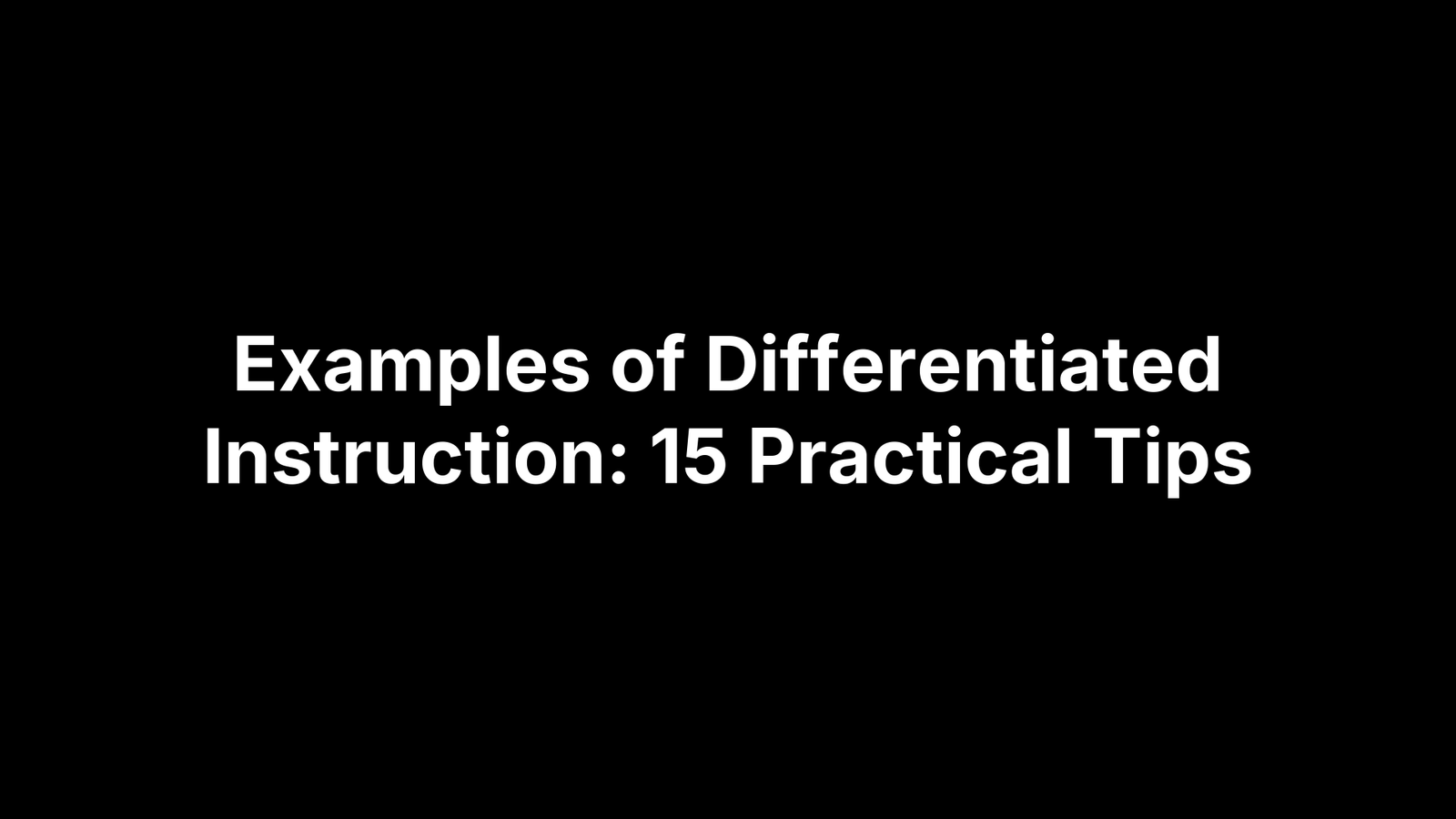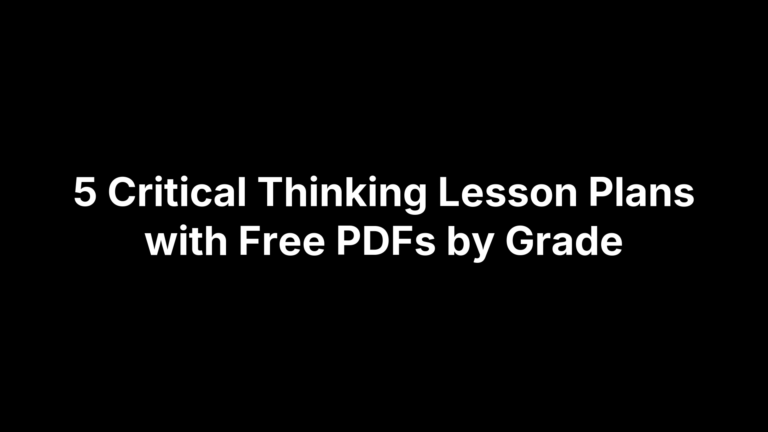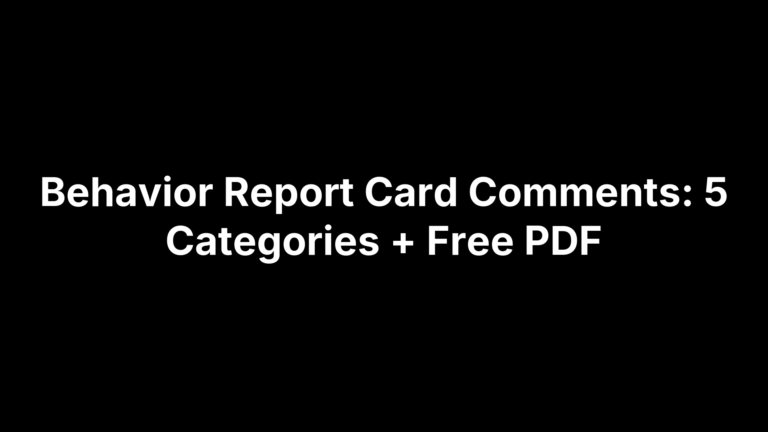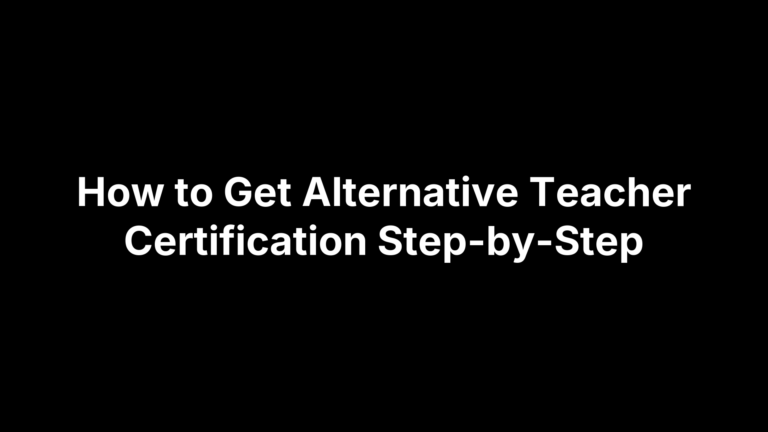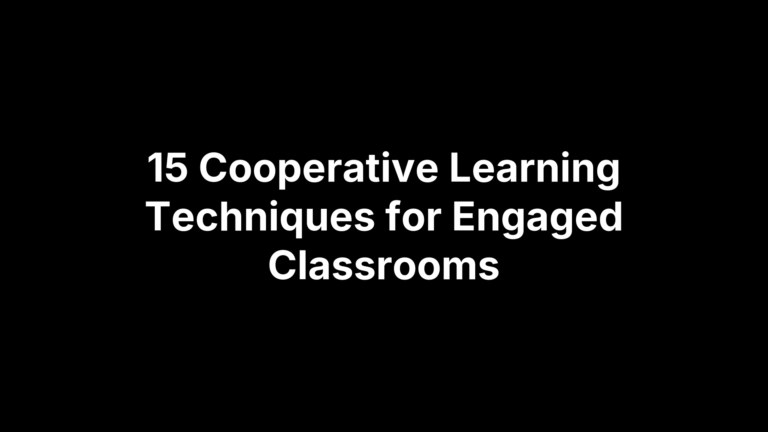Examples of Differentiated Instruction: 15 Practical Tips
Differentiated instruction (DI) means intentionally adjusting content, learning processes, final products, or the classroom environment so every student can tackle the same standard at a just-right level of challenge. Think of it as adjusting the volume rather than changing the song. If you want concrete ideas rather than theory, keep reading—this guide delivers, and it’s completely doable.
Here’s a quick preview of the 15 classroom-tested moves you’ll find inside:
- AI planning helper
- Flexible grouping
- Multi-modal stations
- Choice boards
- Tiered assignments
- Task cards
- Data-driven exit tickets
- Scaffolded think-pair-share
- Flipped videos
- Varied text sets
- Scaffolded writing
- Jigsaw experts
- Open-ended math
- Learning contracts
- Environment zones
Each strategy maps to at least one of DI’s four pillars—content, process, product, and learning environment—so you can see not only what to try but why it works. Every example is adaptable for any grade or subject, and once routines are set most require almost no extra prep. Use your formative-assessment data to pick the tip that meets your students where they are and jump straight in.
1. Jump-Start Planning With an AI Differentiated Instruction Helper (The Cautiously Optimistic Teacher)
Even the most seasoned educators can burn hours trying to tier a single lesson. The free AI Differentiated Instruction Helper on The Cautiously Optimistic Teacher automates the grunt work so you can focus on students, not spreadsheets.
Why This Counts as Differentiation
- Content: auto-generated leveled texts and vocabulary lists
- Process: scaffold suggestions, graphic organizers, and grouping notes
- Product: tiered writing prompts or project ideas matched to the same standard
One click produces multiple on-ramps and off-ramps, satisfying the core elements of differentiated instruction without starting from scratch.
Step-by-Step Classroom Workflow
- Gather quick data—reading levels, interest survey results, latest exit ticket.
- Paste your standard or objective into the tool.
- Review the three suggested task tiers (approaching, on-level, beyond) and tweak wording or length.
- Export to Google Docs and push to students’ devices or print for stations.
Practical Example: Middle-School Science Lesson
A teacher pastes “explain Newton’s First Law” and receives:
- Tier 1: 250-word passage at 850 L with matching activity
- Tier 2: 350-word passage at 1000 L with data-table analysis
- Tier 3: 450-word passage at 1150 L plus an open-ended design-a-lab prompt
Tips to Maximize Impact
- Combine AI output with your professional judgment—delete fluff, add local references.
- Store polished tiers in a shared drive so the team builds a living bank.
- Use the three versions as tomorrow’s small-group centers; prep is already done.
2. Flexible Grouping Driven by Ongoing Formative Assessment
Grouping isn’t a one-and-done seating chart—it’s a living response to the evidence you gather each day. By shifting students into temporary teams based on exit tickets, quick quizzes, or even clipboard notes, you can target instruction precisely where it’s needed. Among the simplest yet most powerful examples of differentiated instruction, flexible grouping keeps every learner in their zone of productive struggle.
What Flexible Grouping Looks Like
- Homogeneous “skill burst” groups for reteaching a missed concept
- Heterogeneous teams for project work that benefits from mixed strengths
- 3–6 students per group, color-coded for fast identification
- Data sources: last night’s Google Form, MAP growth reports, on-the-fly observations
Implementation Guide
- Set norms: quiet signal, role cards, respectful peer help.
- Post group colors on the board; students move when the timer dings.
- Prepare two-to-four 10-minute mini-lessons; rotate yourself, not the students, to maximize time.
Troubleshooting & Management Hacks
- Use a visible countdown timer to curb transition lag.
- Store group materials in matching colored bins so students grab and go.
- Teach a “group reset” routine—hands up, mouths closed—before regrouping mid-period.
3. Multi-Modal Learning Stations
Rotating through two-to-four purpose-built stations lets students interact with the same concept in different ways—reading, moving, talking, and creating. Because each stop targets a distinct learning modality, everyone gets at least one “sweet-spot” experience without tracking kids by ability. That makes learning stations one of the easiest examples of differentiated instruction to embed in any unit.
Designing Stations Around Learning Modalities
- Reading station (content): annotated article or leveled text
- Kinesthetic station (process): hands-on manipulatives or role-play
- Digital station (product): interactive video quiz or creation app
Post concise task cards, set 12- to 15-minute timers, and train students to reset materials before rotating.
Sample Station Setup for a Fractions Unit
- Manipulatives: build and compare fraction strips
- Interactive video: pause-and-solve problems on Edpuzzle
- Word-problem journal: real-life scenarios, sentence stems provided
Assessment & Reflection
Give each student a “station passport” to record answers, self-rate confidence, and jot lingering questions. Collect passports at the end—tomorrow’s mini-lessons practically plan themselves.
4. Choice Boards and Learning Menus
Few strategies shout “student agency” louder than giving kids a menu of tasks and letting them pick their pathway. Whether you teach algebra or art history, a well-designed choice board turns one lesson into nine micro-options, all aligned to the same objective. It’s one of the quickest examples of differentiated instruction to prep because you’re remixing tasks you already use.
Building a 3×3 Tic-Tac-Toe Choice Board
- Draw a simple grid; label rows Remember/Apply/Create to mirror Bloom’s depth.
- Drop the core requirement in the center square so every student practices the must-know skill.
- Populate the remaining squares with varied product formats—podcast, comic strip, infographic, mini-lab, written reflection—ensuring each hits the target standard.
- Instruct students to complete any three in a line; advanced learners can aim for a blackout.
Differentiation Payoff
Readiness is honored through task complexity, interests through product format, and process through self-pacing. Students feel ownership, yet everyone reaches the same learning destination.
Grading With a Single Rubric
Create one rubric anchored in the standard and scale descriptors (1–4) for depth of understanding. Because criteria stay constant across products, you can assess podcasts and essays side by side without extra grading headaches.
5. Tiered Assignments for Readiness Levels
A tiered assignment targets the same learning goal but offers two-to-three versions calibrated to different readiness levels. Because the topic and deadline stay constant, no one feels singled out—yet each student works in the sweet spot between frustration and boredom.
Quick-Create Method
- Write the on-level task first.
- Consult a depth-of-knowledge (
DOK) wheel. - Lower the floor: trim vocabulary, add graphic support, or chunk steps.
- Raise the ceiling: add a compare/contrast prompt, require evidence, or introduce a real-world twist.
Prep time is minimal, and the result is one of the most efficient examples of differentiated instruction you can deploy.
Elementary ELA Example
Text: “Goldilocks and the Three Bears.”
- Tier 1: Sequence three picture cards.
- Tier 2: Write a five-sentence summary with transition words.
- Tier 3: Analyze how setting influences plot, citing quotes.
Ensuring Rigor for All
Frame tasks with “Must / Should / Could” language so every learner sees a pathway forward and a stretch goal. One common rubric keeps grading consistent.
6. Task Cards for Independent or Partner Practice
Hand-held task cards turn a single worksheet into bite-sized, self-paced challenges. Because students pull only the card they’re ready for, the activity naturally flexes to different readiness levels—one of the simplest examples of differentiated instruction you can prep during a planning period.
Crafting Effective Task Cards
- One clear prompt or problem per card; limit text to fit a 4×6 index card
- Add visuals, sentence stems, or hint icons for embedded scaffolds
- Print answers or QR-linked solutions on the back so students can self-check and adjust in real time
- Color-code borders to signal increasing complexity
Variation: Scoot Activity
Place numbered cards on desks; students “scoot” to the next seat every two minutes. Movement boosts engagement, while quick rotations expose learners to multiple difficulty levels without stigma.
Storage & Reuse
Laminate sets, hole-punch a corner, and clip to binder rings. Store by standard in photo boxes—grab-and-go whenever formative data shows a gap or enrichment need.
7. Exit Tickets That Drive Next-Day Differentiation
Exit tickets are one-question snapshots handed out during the last two minutes of class. Used faithfully, they supply laser-focused data that fuels tomorrow’s grouping without adding a single grading stack.
Collecting Actionable Data in Under 3 Minutes
Ask one standards-aligned question and a 1–4 confidence self-rating. Paper sticky notes work, but a quick Google Form auto-sorts by score so gaps and strengths pop instantly.
Planning Tomorrow’s Mini-Lessons
That night, tag responses green, yellow, or red. Next day run three stations: reteach (red), practice (yellow), and extend (green) while the rest work independently.
Sample Prompts Across Subjects
Math: “Explain why 3/4 > 2/3.”
ELA: “Which detail best shows the theme of courage?”
Science: “Claim-Evidence-Reason—does mass affect fall speed?”
History: “Write one sentence summarizing today’s primary source.”
8. Think-Pair-Share With Scaffolded Prompts
Think-Pair-Share is already a formative gem; add micro-scaffolds and it morphs into on-the-fly differentiation that costs zero prep dollars. By tuning the “think” prompt, giving targeted stems, and capturing responses, every student—shy, struggling, or soaring—gets a tailored cognitive workout.
Adding Differentiation to a Classic Strategy
- Prep two or three versions of the question, each labeled 🔹, 🔸, or ⭐.
- Distribute based on last exit-ticket data; students quietly jot ideas.
- Provide sentence starters (“One possible cause is…”) or quick-sketch boxes for those who need them.
- All share the same pair and class discussion, keeping community intact.
Managing Time and Accountability
Set a visible 60-second timer for each phase. Use a gallery of digital sticky notes (Jamboard or Padlet) so you can scan for misconceptions and call on pairs strategically.
Extending for Advanced Learners
After whole-class share, invite ready pairs to form a “pair-square.” Their task: synthesize two other groups’ ideas into a concise summary or counterargument posted to the board, upping the rigor without extra worksheets.
9. Flipped Classroom Videos With Tiered Supports
A flipped lesson frees up class time for hands-on work, but it can also become one of the most flexible examples of differentiated instruction when you offer more than one version of the video and layer in supports. Students engage with content at their own pace at home, then arrive ready for targeted practice or extension.
Creating or Curating Variable-Length Videos
- Produce 3-, 6-, and 9-minute takes on the same concept, each hitting identical learning targets.
- Add closed captions, adjustable playback speed, and downloadable notes for extra accessibility.
- Quick hack: clip existing YouTube segments with Edpuzzle to control length and add prompts.
During-Class Differentiation
- Reteach Station: students who scored below 70 % on the embedded quiz get a brief small-group lesson.
- Practice Zone: on-track learners tackle application problems with peer support.
- Extend Corner: advanced students pursue an open-ended project or debate inspired by the video.
Tracking Engagement and Understanding
- Embedded multiple-choice and short-answer checks auto-grade, giving you color-coded data before the bell rings.
- Export reports to sort tomorrow’s groups or identify misconceptions within minutes.
10. Varied Text Sets at Multiple Lexile Levels
Swapping a single “one-size” article for a deliberately leveled text set is one of the quickest examples of differentiated instruction you can implement. When every student explores the same topic through material that matches their reading stamina, comprehension sky-rockets and whole-class discussions get meatier.
Building a Text Set
- Curate 4–5 pieces on the same theme—say renewable energy—ranging roughly 600L to 1200L.
- Mix formats: infographic, short news brief, primary-source excerpt, and a longer deep-dive.
- Label each with Lexile and an interest hook so students can self-select or you can assign.
Jigsaw Reading Routine
Students first annotate their assigned text, then regroup into mixed “teaching teams” to share three takeaways and one lingering question, turning varied input into peer-crafted synthesis.
Sources for Free Leveled Articles
Try NASA’s Climate Kids, CDC fact sheets, Smithsonian Tween Tribune, or government portals like NOAA; all offer comparable content at multiple readability bands without paywalls.
11. Scaffolded Writing With Sentence Starters and Frames
Writing is the moment of truth for many learners—ideas are there, but getting them on paper feels like climbing a greased pole. Purpose-built sentence starters and paragraph frames trim away the mechanics, giving every student a fair shot at communicating content mastery. Better yet, these supports are quick to make and reusable, making them one of the most teacher-friendly examples of differentiated instruction.
Differentiation by Process
Offer a sliding scale of scaffolds: a cloze paragraph for emerging writers, a bulleted frame with transition banks for on-level students, and an open graphic organizer for those ready to fly. The learning target stays constant—only the level of structural support shifts.
Gradual Release Model
Model a complete paragraph (I Do), co-construct one with the class (We Do), then let students draft independently (You Do) while still referencing their chosen frame. Gradually fade the starters over successive drafts to build stamina.
Assessment Tips
Use a single-point rubric focused on idea development and evidence. As scaffolds diminish, track growth by highlighting removed supports rather than merely counting errors—students see progress in real time.
12. Jigsaw Method With Expert Sheets
The classic jigsaw turns every learner into the class “go-to” for a slice of the lesson, building both content mastery and interdependence. Expert sheets—tiered packets of guiding questions, visuals, and vocabulary—supercharge the routine by matching support to readiness rather than one-size handouts.
Structuring Expert Roles
- Group students into home teams of four.
- Assign each member a subtopic labeled 🟢, 🔵, or 🔴 to signal scaffold level.
- Distribute matching expert sheets:
- 🟢 concise summary + graphic organizer
- 🔵 medium-length text + analysis prompts
- 🔴 primary source excerpt + extension question
- Send students to “expert corners” to master material before returning to teach their home team.
Accountability Systems
Quick expert quizzes, color-coded note templates, and a group goal score keep everyone on the hook for clear explanations and active listening.
Cross-Curricular Example
Social studies: branches of government; science: parts of a cell; ELA: themes across short stories—any multi-part topic fits. Rotate roles next unit so every student tackles higher tiers over time.
13. Open-Ended Math Problems and Anchor Activities
Tired of finishing-fast students tugging at your sleeve while others still wrestle with step one? Pairing rich, open-ended problems with ready-to-go anchor activities solves both issues in one shot. The class tackles the same compelling scenario, yet the multiple solution pathways invite natural stretch or support, making it a textbook example of differentiated instruction in mathematics.
Designing Open-Ended Tasks
- Pose a real-world context (e.g., plan seating for a school play within fire-code limits).
- Write a prompt that asks, “How many different solutions can you find?” or “Explain your reasoning.”
- Include intentionally ambiguous data so students must decide what matters and justify choices.
Anchor Activity Bins
Stock bins with puzzles, math journals, and self-checking digital practice. Early finishers grab an anchor without permission; those who need more time keep working uninterrupted.
Differentiation Gains
Struggling learners focus on one valid strategy; advanced peers explore optimization, pattern hunting, or algebraic generalization. Everyone is engaged, no extra grading pile required.
14. Learning Contracts for Independent Projects
A learning contract turns an independent project into a shared agreement. Students steer the topic; you supply structure, ensuring freedom doesn’t slide into chaos—classic differentiated instruction without daily micromanaging.
Building a Contract
- Choose a standards-aligned topic the learner genuinely cares about.
- List must-do criteria and could-do stretch goals.
- Offer two or three product formats—slide deck, model, podcast.
- Map proposal, midpoint, and final showcase dates.
- Attach a single-point rubric co-created with the student.
Monitoring Progress
Block five-minute weekly conferences to review evidence and adjust goals. Keep the living document in Google Docs so comments capture growth automatically and both parties stay accountable.
Success Story Template
Fourth-grader Kayla picked simple machines, researched levers, drafted blueprints, and built a cardboard arcade game classmates could test—standards met, engagement off the charts.
15. Classroom Environment Zones for Sensory and Learning Preferences
The physical setup of your room can differentiate learning as powerfully as any worksheet. By carving out clearly labeled zones—each tuned for a particular sensory or collaboration need—you give students instant, stigma-free options for focusing, partnering, or recharging. It’s one of the most overlooked yet impactful examples of differentiated instruction because the structure works quietly in the background all year.
Mapping Zones
- Quiet Nook: soft lighting, beanbags, privacy screens for deep reading
- Collaboration Table: large surface, whiteboard center, talking allowed
- Standing Desks: high tables or podiums for movers and shakers
- Floor Area: clipboards, rugs, and pillows for sprawlers
Post a simple chart showing which tasks fit each zone so movement stays purposeful.
Student Choice & Self-Regulation
Teach students to gauge their own focus level, choose the best zone, and set a timer if needed. Quick exit tickets can ask, “Which zone helped you most today and why?”—reinforcing metacognition.
Budget-Friendly Setup Ideas
- DIY lap desks from $1 cookie sheets
- Thrift-store rugs and pillows, sanitized nightly
- Noise-reducing headphones funded through a classroom wish list
Bringing It All Together
Taken together, the 15 ideas above give you at least one entry point for every pillar of differentiated instruction. Choice boards, tiered assignments, and varied text sets flex content; think-pair-share, stations, and flipped videos adjust process; learning contracts and open-ended math tasks diversify products; environment zones reshape the very context in which learning happens. Starting tomorrow you can pick two or three that match your formative data and layer in others as routines solidify. Remember, differentiation isn’t about 15 separate gimmicks—it’s a mindset of responding to evidence in real time. For deeper dives and time-saving AI tools, swing by the homepage of The Cautiously Optimistic Teacher and grab what you need.
